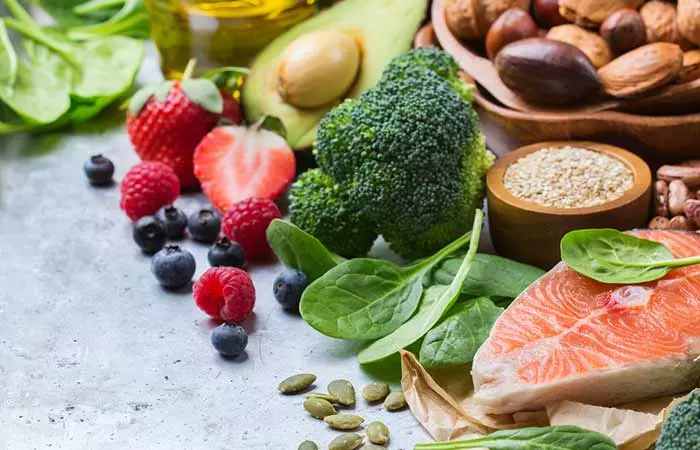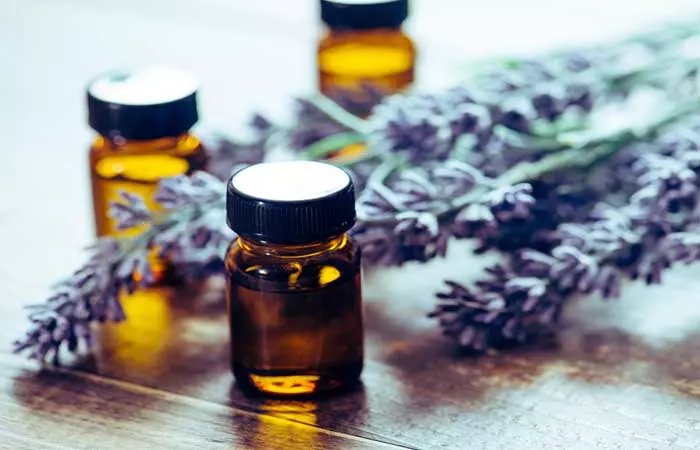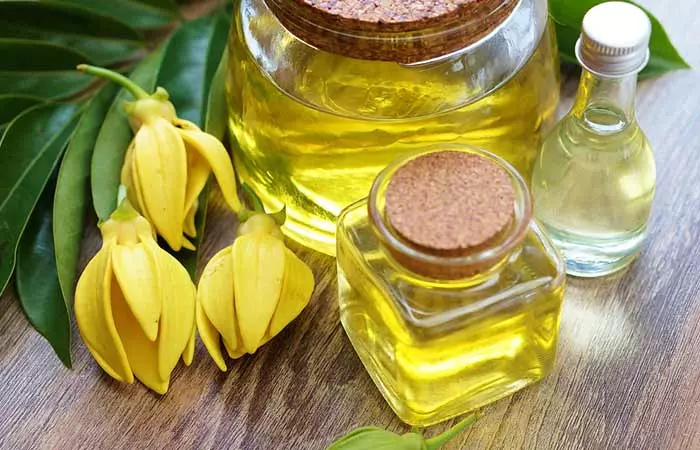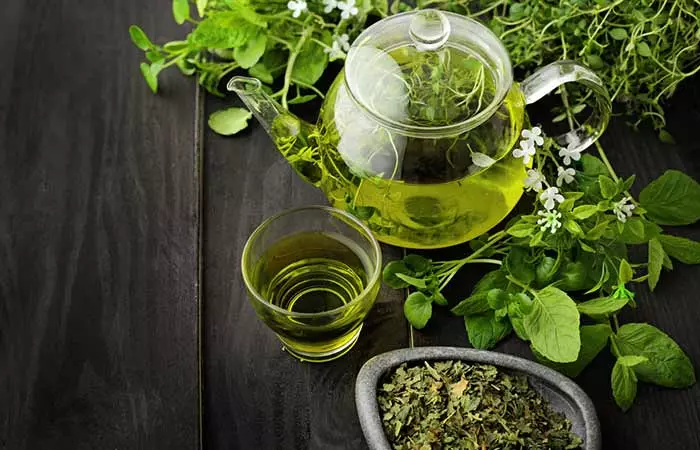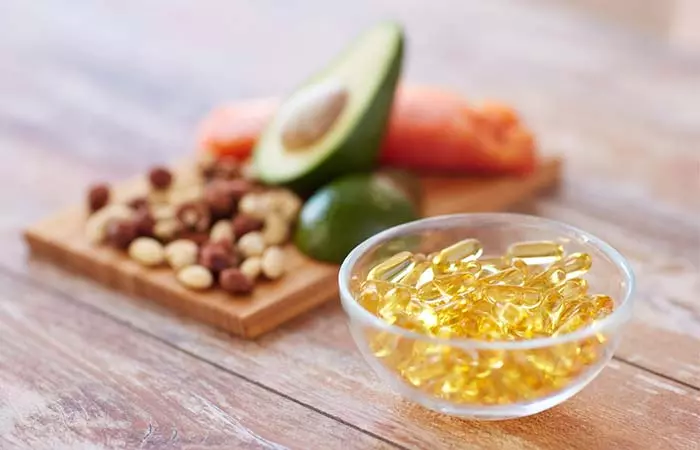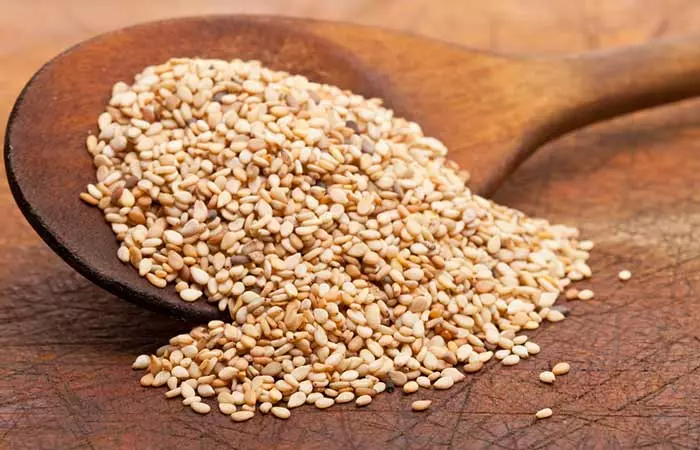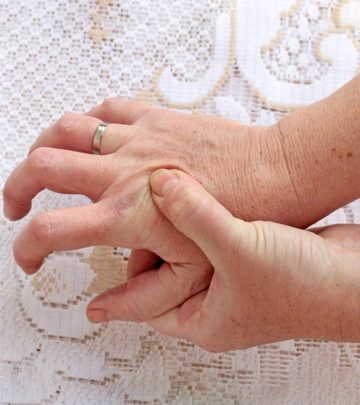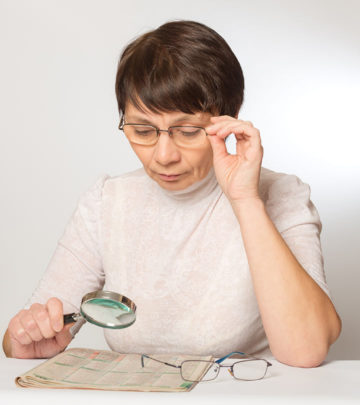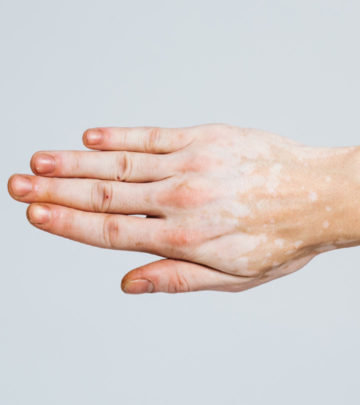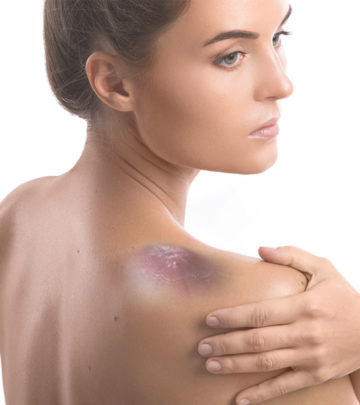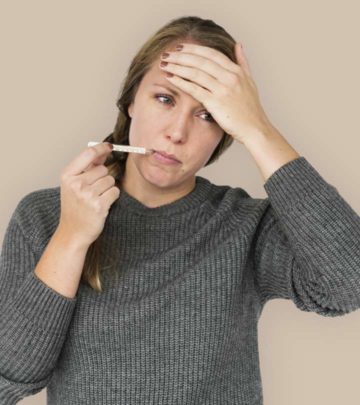Premenstrual Syndrome – Symptoms, Causes, And 14 Remedies + Diet Tips

More than 85% of menstruating women experience premenstrual syndrome.
PMS or premenstrual syndrome is no joke. I am sure most of you girls out there know what I am talking about. Those days when all you feel like is either crying your heart out or simply indulging in a bucket full of chocolate ice cream for no apparent reason – you know for a fact that your monthly guest is right next door. Most women tend to resort to painkillers to get relief from the symptoms of PMS. However, there are natural cures for this condition. To know all about them and more, read on.
Table Of Contents
- What Is Premenstrual Syndrome?
- Causes Of And Risk Factors For Premenstrual Syndrome
- Signs And Symptoms
- Diagnosis
- 13 Home Remedies To Treat Premenstrual Syndrome
- Best Diet For Premenstrual Syndrome (PMS)
- Alternative Medicine
- Prevention Tips
What Is Premenstrual Syndrome?
Premenstrual syndrome is a condition that is associated with the onset of a woman’s menstrual cycle. A woman’s physical health, emotions, and even behavior may be affected during certain days of her menstrual cycle, i.e., just before the onset of her periods. These changes are collectively termed premenstrual syndrome (PMS).
The symptoms of premenstrual syndrome often surface 5 to 11 days prior to menstruation and typically subside once menstruation begins. A more severe and disabling form of premenstrual syndrome that is known to affect 3-8 % of menstruating women is called the premenstrual dysphoric disorder.
Although the exact cause of premenstrual syndrome is yet to be determined, many researchers are of the opinion that it is related to changes in the sex hormone as well as the serotonin levels at the beginning of the menstrual cycle.
Let us now look at the causes and risk factors for premenstrual syndrome.
Causes Of And Risk Factors For Premenstrual Syndrome
Just before the onset of your periods, the levels of the female sex hormones, estrogen and progesterone, increase in your body. An increase in these hormones can result in mood swings, irritability, and symptoms of anxiety.
Serotonin is another chemical (neurotransmitter) present in your brain and gut that can affect your mood, emotions, and thoughts. A decrease in the levels of this chemical is also attributed to mood changes.
Premenstrual syndrome is believed to be caused by the changes in the levels of these sex hormones and chemicals.
Other factors that can increase your risk of developing premenstrual syndrome are:
- A family history of premenstrual syndrome
- A family history of depression
- Substance abuse
- Emotional or physical abuse or trauma (e.g., domestic violence)
Premenstrual syndrome is also associated with other conditions like:
- Dysmenorrhea
- Schizophrenia
- Anxiety disorder
- Major depressive disorder
But it doesn’t mean that if you have PMS, you will also develop these conditions. It’s more likely that women who have these conditions suffer more from PMS because they are already feeling off balance.
The symptoms associated with premenstrual syndrome can be mild to moderate. Also, the severity of the symptoms varies from individual to individual.
Some of the most common symptoms that surface due to premenstrual syndrome are listed below.
Signs And Symptoms
Physical Symptoms
- Soreness of breasts
- Abdominal pain and bloating
- Acne
- Muscle/joint ache
- Headache
- Fatigue and weakness
- Fluid retention, leading to weight gain
- Constipation or diarrhea
- Intolerance to alcohol
Emotional And Behavioral Symptoms
- Food cravings, especially sweets
- Anxiety and depression
- Spells of crying out of the blue
- Mood swings that lead to irritability or anger
- Changes in appetite
- Social withdrawal
- Changes in one’s libido
- Decrease in concentration
- Insomnia or trouble in falling asleep
Let us now find out how your doctor can diagnose if you are suffering from premenstrual syndrome.
Diagnosis
There is no specific test to find out whether an individual is suffering from premenstrual syndrome or not. Your doctor is likely to rely on your reporting the signs and symptoms that surface right before your periods. You can make a record of them in a calendar or diary before confirming your condition.
Premenstrual syndrome can often be managed naturally, especially if the symptoms are mild to moderate. Any of the remedies listed below can help you in the treatment and management of premenstrual syndrome successfully.
13 Home Remedies To Treat Premenstrual Syndrome
- Black Cohosh
- Ginkgo Biloba
- Vitamins
- Minerals
- Essential oils
- Chasteberry
- Ginger
- Green Tea
- Pickle Juice
- Kombucha
- Omega 3
- Raspberry Leaf Tea
- Black Pepper
- Sesame Seeds
How To Treat Premenstrual Syndrome Naturally
1. Black Cohosh
You Will Need
- 1 teaspoon of black cohosh root
- 1 cup of water
What You Have To Do
- Add a teaspoon of black cohosh root to a cup of water.
- Bring it to a boil in a saucepan.
- Simmer for about 5 minutes and strain.
- You can add some honey to the tea to enhance its flavor.
- Drink it.
How Often You Should Do This
Drink black cohosh tea at least twice daily.
Why This Works
Black cohosh is popular for its use as a pain blocking agent to reduce pain and cramping associated with premenstrual syndrome with its analgesic properties (1). It is also a phytoestrogen that can help balance estrogen in the body.
2. Ginkgo Biloba
You Will Need
- 1 tablespoon of ginkgo biloba dried leaves
- 1 cup of water
What You Have To Do
- Add a tablespoon of ginkgo biloba dried leaves to a cup of hot water.
- Steep for 5 to 10 minutes and strain.
- Consume the hot tea.
How Often You Should Do This
Have 1 to 2 cups of ginkgo biloba tea daily.
Why This Works
Ginkgo biloba is another excellent remedy for premenstrual syndrome. According to an article published in the Journal of Alternative and Complementary Medicine, ginkgo biloba was found to decrease the severity of the overall physical and psychological symptoms associated with premenstrual syndrome (2).
3. Vitamins
Vitamins B6, D, and E help in relieving symptoms of premenstrual syndrome. These vitamins proved to be effective in treating the overall PMS symptoms such as anxiety, breast tenderness, etc. (3), (4).
Hence, it is important that you incorporate more of these vitamins into your diet by consuming foods like fish, poultry, eggs, soy products, mushroom, dairy, nuts, and green leafy vegetables. You can take additional supplements for any of these vitamins but only after consulting your doctor.
Why They Work
Vitamin B6 is a natural diuretic and helps reduce the fluid retention that builds up the week before the period. If you use Vitamin D, make sure you don’t take more than 2,000 IU per day and take it with magnesium. Vitamin E can be especially useful for premenstrual breast pain.
4. Minerals
Magnesium treats many aspects of PMS. In a study, 192 women were given 400 mg of magnesium daily for PMS. The study found that 95% of the women experienced less breast pain and had less weight gain, 89% had less nervous tension, and 43% had fewer headaches.
5. Essential Oils
a. Lavender Oil
You Will Need
- 6 drops of lavender oil
- 1 teaspoon of coconut oil or any other carrier oil
What You Have To Do
- Add six drops of lavender oil to a teaspoon of coconut or any other carrier oil.
- Mix well and apply it to your lower abdomen and behind your neck.
- Massage gently for a few minutes and leave it on.
How Often You Should Do This
Do this 1 to 2 times daily.
Why This Works
Lavender oil is undoubtedly the best essential oil for treating premenstrual syndrome. The analgesic and anti-inflammatory properties of lavender oil help relieve pain and cramps while its other actions alleviate symptoms of anxiety and depression (5), (6).
b. Ylang Ylang Oil
You Will Need
- 6 drops of ylang ylang oil
- 1 teaspoon of coconut or any other carrier oil
What You Have To Do
- Add six drops of ylang ylang oil to a teaspoon of any carrier oil.
- Mix well and apply it to your lower abdomen, behind your ears, and your temples.
- Gently massage for a minute and leave it on.
How Often You Should Do This
You can do this 2 to 3 times daily.
Why This Works
Ylang ylang oil has sedative properties that induce relaxation and promote sleep (7). The oil also has anti-inflammatory properties that reduce symptoms of pain that occur with premenstrual syndrome (8).
6. Chasteberry
You Will Need
- 2 cups of water
- ½ tablespoon of chasteberry
What You Have To Do
- Add half a tablespoon of crushed chasteberry to two cups of hot water.
- Steep for 10 minutes and strain.
- Drink the tea hot or cold as per your choice.
How Often You Should Do This
You can drink this tea 1 to 2 times daily.
Why This Works
Chasteberry is the fruit that comes from the chaste tree (Vitex agnus castus). Most women rely on the tea made from this herb to soothe their PMS symptoms (9). Unlike black cohosh, chasteberry enhances progesterone, not estrogen. So, depending on your PMS symptoms, you could use one or the other.
7. Ginger
You Will Need
- 2 inches of ginger
- 1 cup of water
What You Have To Do
- Add the ginger to a cup of hot water.
- Steep for 10 minutes and strain.
- Drink the tea.
How Often You Should Do This
Drink this concoction twice daily for best results.
Why This Works
Ginger has proven to help treat symptoms like nausea, vomiting, and motion sickness. Although the etiology behind this is not clear, ginger also helps reduce physical and behavioral symptoms that surface with premenstrual syndrome (10).
8. Green Tea
You Will Need
- ½ teaspoon of green tea
- 1 cup of hot water
What You Have To Do
- Add half a teaspoon of green tea to a cup of hot water.
- Steep for 5 to 10 minutes and strain.
- Consume the green tea.
How Often You Should Do This
You can do this twice daily.
Why This Works
Green tea will not only keep you hydrated throughout the day but also prevent water retention due to its diuretic effects. Its anxiolytic and anti-inflammatory effects can help reduce muscle cramps, pain, acne outbreaks, and anxiety associated with PMS (11), (12).
9. Pickle Juice
You Will Need
2.5 ounces or 5 tablespoons of pickle juice
What You Have To Do
Keep sipping on small amounts of pickle juice when you experience PMS.
How Often You Should Do This
Follow this remedy only as and when required.
Why This Works
While you should try and avoid salty foods when you are experiencing fluid retention symptoms of premenstrual syndrome, pickle juice is an exception. The high electrolyte content of pickle juice is believed to be great to relieve muscle cramps that often surface before or during your periods.
10. Kombucha
You Will Need
½ – 1 cup of store-bought kombucha
What You Have To Do
Consume half to one cup of kombucha.
How Often You Should Do This
You can drink kombucha once daily until your PMS symptoms get better.
Why This Works
Kombucha is a fermented tea made with B vitamins and specific harmless strains of bacteria and yeast. Its probiotic nature and ability to synthesize B vitamins help in treating symptoms of premenstrual syndrome (13). As we have already mentioned, vitamin B6 is one of the many nutrients that help in reducing the severity of premenstrual syndrome symptoms.
11. Omega-3
You Will Need
250-500 mg omega-3 fatty acids
What You Have To Do
Incorporate omega-3s into your diet. You can either consume natural sources of omega-3s like fatty fish, green leafy veggies, walnuts, and flax seeds or take supplements.
How Often You Should Do This
You must do this on a daily basis.
Why This Works
Premenstrual syndrome can also be treated by supplementing omega-3 fatty acids in affected women. In a study published in The Journal of Psychosomatic Obstetrics & Gynecology, omega-3 was shown to reduce the symptoms of PMS while also improving the affected individual’s quality of life (14).
12. Raspberry Leaf Tea
You Will Need
- 1 teaspoon of raspberry leaf tea
- 1 cup of hot water
What You Have To Do
- Steep a teaspoon of raspberry leaf tea in a cup of hot water for 5 minutes.
- Strain and allow it to cool for a while.
- Drink the warm tea.
How Often You Should Do This
You can drink raspberry leaf tea twice daily.
Why This Works
Raspberry leaf tea is a rich source of certain flavonoids, tannins, and nutrients like magnesium and calcium, all of which collectively help relieve the symptoms of premenstrual syndrome such as cramps (15). It also helps balance the hormones preventing symptoms of nausea, vomiting, and diarrhea.
13. Black Pepper
You Will Need
- A pinch of black pepper
- 1 tablespoon of aloe vera gel
What You Have To Do
- Mix a pinch of black pepper powder with a tablespoon of aloe gel.
- Consume the mixture.
How Often You Should Do This
You can do this once daily until your symptoms subside.
Why This Works
Pepper contains an active phenolic compound called piperine that has anti-inflammatory and analgesic properties. These properties help alleviate pain and inflammation associated with premenstrual syndrome (16).
14. Sesame Seeds
You Will Need
2 tablespoons of sesame seeds
What You Have To Do
Roast two tablespoons of sesame seeds and add it to your favorite salads or smoothies.
How Often You Should Do This
You can consume these seeds 1 to 2 times daily until your symptoms get better.
Why This Works
Sesame seeds are great for reducing inflammation and muscle spasms that often surface with premenstrual syndrome. This is due to their powerful anti-inflammatory activities (17).
All these remedies are quite effective in alleviating PMS symptoms. You must also be aware of the foods that can alleviate or worsen your symptoms to help you deal with the condition better.
Best Diet For Premenstrual Syndrome (PMS)
What To Eat
- Vitamin B-rich foods like beans, legumes, turkey, chicken, and salmon.
- Anti-inflammatory foods or foods rich in omega-3 fatty acids like fatty fish, nuts, seeds, and beans.
- Calcium-rich foods like dairy, sunflower seeds, kale, spinach, and soybeans.
- Magnesium-rich foods like 100% cacao, nuts, seeds, kale, spinach.
- Diuretic foods that are high in water content like cucumbers, onions, watermelons, cucumbers, and tomatoes.
What Not To Eat
- High sodium foods like fast foods and canned foods as they increase water retention in the body.
- Sugary foods like pastries, chocolates, and artificial sweeteners.
- Fried foods
- Alcohol
- Caffeine
Most cases of premenstrual syndrome will show improvement by following the remedies and diet tips mentioned here. However, for more severe cases, such as premenstrual dysphoric disorder, your doctor may ask you to avail medical treatments like the ones mentioned below. Those treatments might include bioidentical progesterone.
Alternative Medicine
The following medications might be prescribed short-term for women suffering from severe episodes of premenstrual syndrome. You can still do the natural remedies mentioned above if you are on medication.
- Antidepressants like fluoxetine (Prozac, Sarafem), paroxetine (Paxil, Pexeva), and sertraline (Zoloft)
- Nonsteroidal anti-inflammatory drugs like ibuprofen (Advil, Motrin IB, others) or naproxen sodium (Aleve)
- Diuretics
- Contraceptives
You can follow the tips mentioned below to prevent recurrence of the condition.
Prevention Tips
- Exercise regularly.
- Get enough sleep.
- Try yoga to relieve stress and anxiety.
- Indulge in deep breathing and meditation exercises.
- Quit smoking.
- Manage your stress.
Premenstrual syndrome can affect a woman’s life in more ways than one could imagine. Hence, a little extra care and understanding will make things far better for her and those around her.
However, if the symptoms of PMS persist or worsen over time, it is best to avail medical help.
Did you find this post helpful? For any suggestions or advice, please use the comment box below.
Frequently Asked Questions
How early do you get your PMS symptoms before your periods?
The symptoms of PMS usually surface 5 to 10 days before the onset of the period for most women. These symptoms usually dissipate once the period begins, which is when estrogen and progesterone levels plunge to release the menstrual flow.
What do cramps a week before period indicate?
If you have started experiencing period cramps as early as a week before your actual periods, it usually indicates that your egg has been fertilized and is attaching itself to your uterus lining. If the egg is not fertilized, the cramps may begin 2 or 3 days before your periods.
How long after conception does a woman know she is pregnant?
Usually, two weeks after conception or six weeks after a missed period, a woman’s breasts become fuller, and her nipples tend to become more sensitive. A missed period is one of the first signs of a successful conception or pregnancy. Other signs include increased urinary frequency, fatigue, and nausea.
How long does premenstrual dysphoric disorder (PMDD) last?
The premenstrual dysphoric disorder is associated with severe symptoms that may surface as a result of premenstrual syndrome. It lasts anywhere from 7 to 10 days.
Is premenstrual dysphoric disorder (PMDD) a mental disorder?
Although psychiatrists were slow in recognizing PMDD as a disorder, the Diagnostic and Statistical Manual of Mental Disorders (DSM-5) now lists premenstrual dysmorphic disorder as a distinct mental disorder.
When to see your doctor for PMS symptoms?
If you have been facing issues with PMS symptoms that show no improvement despite availing natural treatment or making changes to your lifestyle, it is best to visit your doctor and seek medical advice for your condition.
References
1. “Black cohosh: coming full circle?” The Journal of Ethnopharmacology, US National Library of Medicine
2. “A randomized, placebo-controlled trial of Ginkgo biloba L. in the treatment of premenstrual syndrome” Journal of Alternative and Complementary Medicine, US National Library of Medicine
3. “Efficacy of vitamin B-6 in the treatment of premenstrual syndrome: systematic review” The BMJ, US National Library of Medicine
4. “Evaluating the effects of vitamin D and vitamin E supplement on premenstrual syndrome: A randomized, double-blind, controlled trial” Iranian Journal of Nursing and Midwifery Research, US National Library of Medicine
5. “Antioxidant, analgesic and anti-inflammatory effects of lavender essential oil” Anais da Academia Brasileira de Ciências, US National Library of Medicine
6. “Essential oil of lavender in anxiety disorders: Ready for prime time?” Journal of Mental Health & Clinical Psychology, US National Library of Medicine
7. “Relaxing effect of ylang ylang oil on humans after transdermal absorption” Phytotherapy Research, US National Library of Medicine
8. “Traditional Uses, Phytochemistry, and Bioactivities of Cananga odorata (Ylang-Ylang)” US National Library of Medicine
9. “Treatment of premenstrual syndrome with a phytopharmaceutical formulation containing Vitex agnus castus” Journal of Women’s Health & Gender-Based Medicine, US National Library of Medicine
10. “Effect of Treatment with Ginger on the Severity of Premenstrual Syndrome Symptoms” ISRN Obstetrics and Gynecology, US National Library of Medicine
11. “Anxiolytic properties of green tea polyphenol (-)-epigallocatechin gallate (EGCG)” Brain Research, US National Library of Medicine
12. “Anti-inflammatory Action of Green Tea” Anti-Inflammatory & Anti-Allergy Agents in Medicinal Chemistry, US National Library of Medicine
13. “A Review on Kombucha Tea—Microbiology, Composition, Fermentation, Beneficial Effects, Toxicity, and Tea Fungus” Wiley Online Library
14. “The effect of omega 3 fatty acid supplementation on premenstrual syndrome and health-related quality of life: a randomized clinical trial” The Journal of Psychosomatic Obstetrics & Gynecology, US National Library of Medicine
15. “Berry Leaves: An Alternative Source of Bioactive Natural Products of Nutritional and Medicinal Value” Antioxidants, US National Library of Medicine
16. “Analgesic and anti-inflammatory activities of Piper nigrum L.” Asian Pacific Journal of Tropical Medicine, US National Library of Medicine
17. “Effects of sesame seed supplementation on inflammatory factors and oxidative stress biomarkers in patients with knee osteoarthritis”, US National Library of Medicine

Community Experiences
Join the conversation and become a part of our vibrant community! Share your stories, experiences, and insights to connect with like-minded individuals.
Read full bio of Dr. Jennifer Mercier




